Can Scoliosis Cause Pain?
It may seem obvious that a bent and twisted spine would be painful right? However not until recently there has not been much research into the link between scoliosis and pain. With this lack of research, healthcare professionals have been previously taught in school that there is no correlation between scoliosis and pain.
Recent research has exposed the myth that scoliosis is not associated with pain. Researchers in Canada have found that in fact it is common for teenagers with scoliosis to suffer from mild, chronic pain [1]. They also found that the pain gets worse the bigger the scoliosis curve gets [2]. These results are further supported by research out of the UK, which found that even children with small curves “had more days off school and were more likely to avoid activities that caused their pain.”
Despite this recent research, it is still common for children that suffer from pain because of a scoliosis to be told, “It is just growing pains” and to not worry about it. This is a concern because if their pain is an indicator of a scoliosis and it is left untreated, then the child will continue to suffer from pain and ultimately the scoliosis can get worse while the child grows. Of interest, the Canadian research also found that those children that were treated for their scoliosis suffered from less pain.
In comparison, with adults it is also a common misunderstanding that scoliosis is not a cause of their back pain. In response to this claim, there in fact is a huge amount of evidence showing a strong link between back pain and scoliosis [1][2][3] and recent evidence also showing a link to neck pain as well [4]. In contrast to children, adults are often told their pain is from other conditions such as spinal stenosis or degenerative disc/joint disease. These conditions very well may be a contributor to the pain they experience, but not the underlying cause. This means patients often seek out or are recommended treatments that are not designed to treat the source of their pain, often resulting in the scoliosis progressing over years until becoming severe with minimal options for treatment. Scoliosis in adults has been recognized as “A medical condition of significant impact, affecting the fastest growing section of our society to a previously unrecognized degree” [5].
With adults diagnosed with scoliosis, there is good news in regards to modern treatment and prevention. A 15-year study was performed that included a group of adult scoliosis patients and found that if left untreated their scoliosis on average progressed approximately 2 degrees per year over 10 years. However, when they were treated with an adult scoliosis brace, it stopped this progression! [1] In addition, evidence shows that bracing in adults with scoliosis can help with the pain caused by scoliosis [2][3].
In summary, scoliosis can be a common cause of spinal pain in both children and adults. Treatment for scoliosis can include specific scoliosis exercise programs prescribed by a expert scoliosis clinician, along with bracing which has shown to help stop or slow the progression of scoliosis [7], and in many cases alleviate pain caused by scoliosis [8][9]. The key to the best outcomes is seeking the correct treatment at the correct time. Do not wait!
For more information about spine health and scoliosis, contact the experts at Optimal Spine & Posture in Boise, ID. Our specialized chiropractors are extensively trained in scoliosis treatment, including specific scoliosis exercise programs, corrective spinal traction, and scoliosis bracing. Call us today to learn more!
References
- Théroux J, Le May S, Fortin C, Labelle H. Prevalence and management of back pain in adolescent idiopathic scoliosis patients: A retrospective study. Pain Research & Management : The Journal of the Canadian Pain Society. 2015;20(3):153-157.
- Théroux J1, Le May S, Hebert JJ, Labelle H.Back Pain Prevalence is Associated with Curve-type and Severity in Adolescents with Idiopathic Scoliosis: A Cross-sectional Study.Spine (Phila Pa 1976). 2016 Nov 18. [Epub ahead of print]
- John K. Birknes, M.D. James S. Harrop, M.D. Andrew P. White, M.D. Todd J. Albert, M.D. Christopher I. Shaffrey, M.D. ADULT DEGENERATIVE SCOLIOSIS: A REVIEW Neurosurgery (2008) 63 (suppl_3): A94-A103.
- Glassman, Steven D. MD*; Berven, Sigurd MD†; Bridwell, Keith MD‡; Horton, William MD§; Dimar, John R. MD*, Correlation of Radiographic Parameters and Clinical Symptoms in Adult Scoliosis.Spine: 15 March 2005 – Volume 30 – Issue 6 – pp 682-688
- Schwab, Frank MD*; Dubey, Ashok MD†; Pagala, Murali PhD‡; Gamez, Lorenzo MD†; Farcy, Jean P. MD* Adult Scoliosis: A Health Assessment Analysis by SF-36. Spine: 15 March 2003 – Volume 28 – Issue 6 – pp 602-606
- Scoliosis Spinal Disord. 2017 Jun 8;12:20. doi: 10.1186/s13013-017-0125-z. eCollection 2017. Neck and back problems in adults with idiopathic scoliosis diagnosed in youth: an observational study of prevalence, change over a mean four year time period and comparison with a control group. Topalis C1,2, Grauers A1,3, Diarbakerli E1,4, Danielsson A5, Gerdhem P1,4.
- MD, PhD Clémence Palazzo, Jean-Paul Montigny, MD, Frédéric Barbot, MD, Bernard Bussel, MD, PhD, Isabelle Vaugier, MD, Didier Fort, MD, Isabelle Courtois, MD, Catherine Marty-Poumarat, MD, Effects of Bracing in Adult With Scoliosis: A Retrospective Study. DOI: 10.1016/j.apmr.2016.05.019
- Weiss HR, Dallmayer R. Brace treatment of spinal claudication in an adult with lumbar scoliosisea case report. Stud Health Technol Inform 2006;123:586-9.
- Weiss HR, Dallmayer R, Stephan C. First results of pain treatment in scoliosis patients using a sagittal realignment brace. Stud Health Technol Inform 2006;123:582-5.




